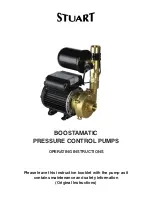
EN-6 452234.66.46 · FD 9306
English
SMW-XP-50TU - SMW-XP-100TU
6 Installation
6.1 General
The water-to-water heat pump must be installed in a frost-free,
dry room on an even, smooth and horizontal surface. The entire
frame should lie directly on the floor to ensure an adequate
soundproof seal. Failing this, additional sound insulation meas-
ures may become necessary.
The heat pump should be installed to allow easy maintenance/
service access. This is ensured if a clearance of approx. 1 m in
front of the heat pump is maintained.
Neither frost nor temperatures higher than 35 °C must occur in
the installation location at any time of the year.
6.2 Sound emissions
The heat pump offers silent operation due to efficient sound insu-
lation. Any vibration transmission to the foundation or the heating
system can be largely prevented by internal sound decoupling
measures.
7 Assembly
7.1 General
The following connections need to be established on the heat
pump:
Flow and return of the well system
Supply/return flow of the heating system
Voltage supply
Temperature sensor
7.2 Connection on heating side
ATTENTION!
The heating system must be flushed prior to connecting the heat pump.
Before completing the heat pump connections on the heating
water side, the heating installation must be flushed in order to re-
move any impurities that may be present, as well as residues of
sealing material, and the like. Any accumulation of deposits in
the condenser may result in a total failure of the heat pump.
Once the installation on the heating side has been completed,
the heating system must be filled, de-aerated and pressure-
tested.
Consideration must be given to the following points when filling
the system:
Untreated filling water and make-up water must be of drin-
king water quality (colourless, clear, free of sediments).
Filling water and make-up water must be pre-filtered (max.
pore size 5 µm).
Scale formation in domestic hot water heating systems cannot be
completely avoided, but in systems with flow temperatures below
60 °C, the problem can be disregarded.
With medium and high-temperature heat pumps, even tempera-
tures above 60 °C can be reached.
The following standard values should therefore be adhered to re-
garding the filling water and make-up water (according to VDI
2035, sheet 1):
Minimum heating water flow
The minimum heating water flow through the heat pump must be
assured in all operating states of the heating system. This can be
accomplished, for example, by installing a dual differential pres-
sureless manifold.
NOTE
The use of an overflow valve is only recommended for panel heating and
a max. heating water flow of 1.3 m³/h. System faults may result if this is
not observed.
Provided the heat pump manager and heating circulating pumps
are ready for operation, the frost protection feature of the heat
pump manager is active. If the heat pump is taken out of service
or in the event of a power failure, the system has to be drained.
In heat pump installations where a power failure cannot be read-
ily detected (holiday house), the heating circuit must contain a
suitable antifreeze product.
7.3 Connection on heat source
side
The following procedure must be observed when making the
connection:
Connect the well pipes to the heat pump's flow and return.
ATTENTION!
It is essential that the dirt trap included in the accessories pack is
installed in the return (inlet).
ATTENTION!
The well water must comply with the required water quality standards.
The hydraulic integration diagram must be adhered to.
P
P
Total heat
output in [kW]
Total alkaline earths
in mol/m³ and/or
mmol/l
Total
hardness in °dH
bis 200
2,0
11,2
200 bis 600
1,5
8,4
> 600
< 0,02
< 0,11
















































